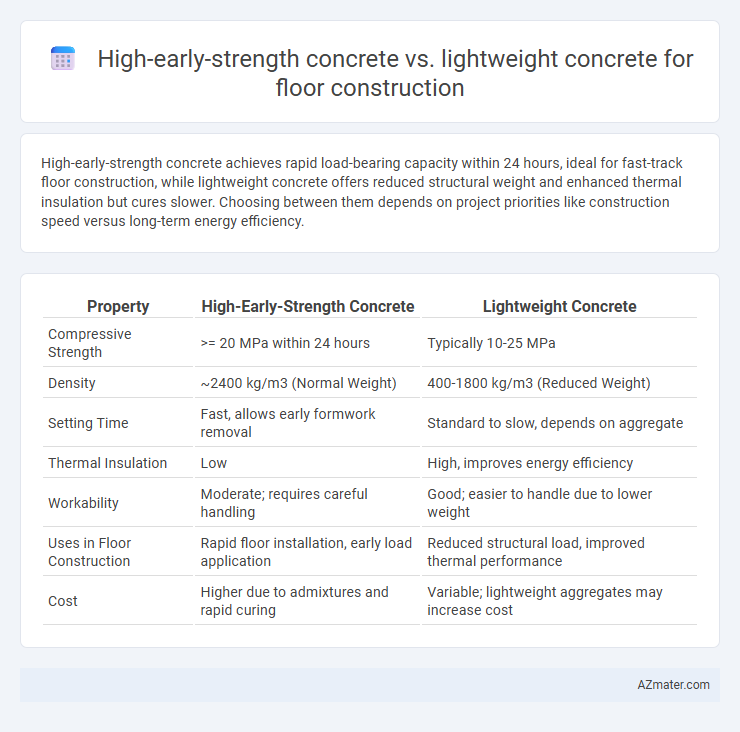High-early-strength concrete achieves rapid load-bearing capacity within 24 hours, ideal for fast-track floor construction, while lightweight concrete offers reduced structural weight and enhanced thermal insulation but cures slower. Choosing between them depends on project priorities like construction speed versus long-term energy efficiency.
Table of Comparison
| Property | High-Early-Strength Concrete | Lightweight Concrete |
|---|---|---|
| Compressive Strength | >= 20 MPa within 24 hours | Typically 10-25 MPa |
| Density | ~2400 kg/m3 (Normal Weight) | 400-1800 kg/m3 (Reduced Weight) |
| Setting Time | Fast, allows early formwork removal | Standard to slow, depends on aggregate |
| Thermal Insulation | Low | High, improves energy efficiency |
| Workability | Moderate; requires careful handling | Good; easier to handle due to lower weight |
| Uses in Floor Construction | Rapid floor installation, early load application | Reduced structural load, improved thermal performance |
| Cost | Higher due to admixtures and rapid curing | Variable; lightweight aggregates may increase cost |
Introduction to Floor Construction Concrete Types
High-early-strength concrete offers rapid setting and high compressive strength within hours, making it ideal for fast-track floor construction projects where quick load-bearing is essential. Lightweight concrete, characterized by reduced density and improved thermal insulation, enhances energy efficiency and structural load management in flooring systems. Selecting the appropriate concrete type depends on project priorities such as construction speed, structural performance, and environmental considerations.
High-Early-Strength Concrete: Definition and Properties
High-early-strength concrete achieves compressive strength typically above 6 MPa within 24 hours, enabling rapid construction and early formwork removal. Its properties include accelerated cement hydration through chemical admixtures or high cement content, resulting in enhanced durability, reduced construction time, and improved load-bearing capacity. This type of concrete is particularly beneficial for floor construction in projects requiring fast turnaround and high structural performance.
Lightweight Concrete: Definition and Key Characteristics
Lightweight concrete is a type of concrete that incorporates lightweight aggregates such as expanded clay, shale, or pumice, resulting in reduced density and improved thermal insulation properties compared to traditional concrete. Its low weight enhances structural efficiency by decreasing dead loads on foundations and supporting elements, making it ideal for floor construction in multi-story buildings. Key characteristics include high fire resistance, good workability, and enhanced sound absorption, which contribute to both safety and comfort in residential and commercial flooring applications.
Strength and Load-Bearing Capacity Comparison
High-early-strength concrete achieves compressive strengths often exceeding 20 MPa within 24 hours, enabling rapid load application and faster construction cycles. Lightweight concrete, with densities typically between 1200-1900 kg/m3, offers reduced dead loads but generally attains lower compressive strengths, ranging from 10 to 30 MPa depending on mix design. For floor construction requiring high load-bearing capacity, high-early-strength concrete provides superior structural performance, while lightweight concrete benefits applications prioritizing weight reduction over maximum strength.
Speed of Construction: Setting and Curing Times
High-early-strength concrete achieves structural strength rapidly, often reaching 70% of its design strength within 24 hours, significantly accelerating the speed of construction for floor slabs. In contrast, lightweight concrete generally exhibits longer setting and curing times due to its lower density and different aggregate composition, which can delay subsequent construction phases. Selecting high-early-strength concrete minimizes downtime and supports fast-track project schedules, making it ideal for projects prioritizing rapid floor installation and load-bearing capacity.
Weight Reduction and Structural Implications
High-early-strength concrete offers rapid load-bearing capacity essential for accelerated construction schedules but typically has a higher density, impacting overall floor weight and structural load. Lightweight concrete significantly reduces dead load by incorporating aggregates like expanded clay or shale, enhancing seismic performance and reducing foundation costs. Choosing between these concretes depends on balancing the need for early strength gain against the benefits of weight reduction and its influence on long-term structural integrity and design requirements.
Thermal and Acoustic Insulation Performance
High-early-strength concrete offers rapid curing and superior load-bearing capacity but generally exhibits lower thermal and acoustic insulation compared to lightweight concrete. Lightweight concrete, characterized by its porous aggregate composition such as expanded clay or shale, significantly enhances thermal resistance and sound absorption, making it ideal for energy-efficient and noise-sensitive floor construction. The thermal conductivity of lightweight concrete can be as low as 0.12 W/m*K, substantially outperforming the typical 1.4 W/m*K seen in high-early-strength concrete, while its density reduction also contributes to improved acoustic dampening properties.
Workability and Placement Considerations
High-early-strength concrete offers rapid strength gain, enabling faster construction schedules but requires precise water control to maintain workability and avoid premature stiffening. Lightweight concrete provides improved thermal insulation and reduced dead load, yet demands careful handling to prevent segregation and ensure even placement due to its lower density and higher air content. Both materials necessitate tailored vibration and finishing techniques to achieve uniform compaction and surface quality in floor applications.
Cost Analysis: Material and Labor Perspectives
High-early-strength concrete offers rapid curing times, reducing labor costs by enabling faster project completion and earlier load application, but its material costs are generally higher due to specialized additives and cement blends. Lightweight concrete, while typically cheaper in raw materials like aggregates, may require additional labor for handling and placement due to its lower density and unique mix consistency, potentially increasing overall labor expenses. Considering total project costs, high-early-strength concrete often results in cost savings through expedited construction schedules despite higher initial material prices, whereas lightweight concrete may lower material costs but incur longer labor durations.
Best Applications: Choosing the Right Concrete for Floors
High-early-strength concrete is ideal for floor construction projects requiring rapid turnaround times, such as commercial buildings and repair works, due to its accelerated curing and early load-bearing capacity. Lightweight concrete is best suited for floors in multistory buildings and structures where reducing dead load and enhancing thermal insulation are critical. Selecting the appropriate concrete depends on balancing load requirements, construction speed, and thermal performance for the specific floor application.

Infographic: High-early-strength concrete vs Lightweight concrete for Floor construction
 azmater.com
azmater.com